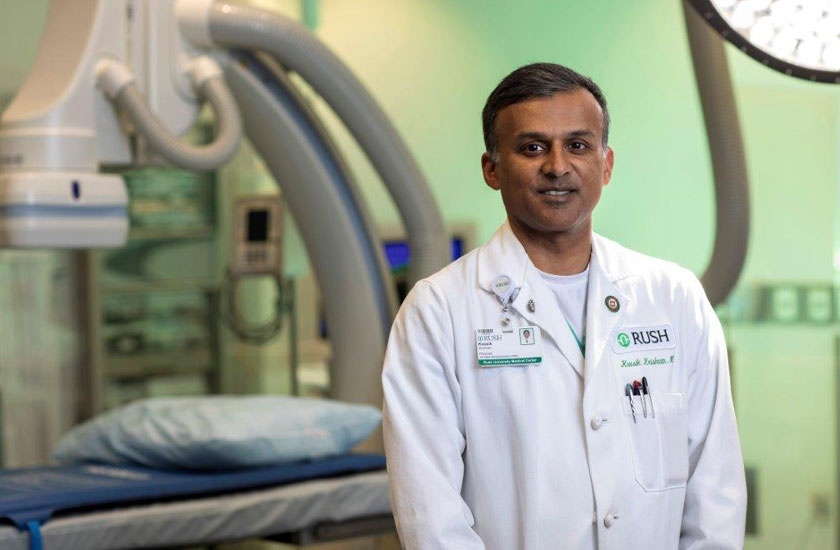CHICAGO – Rush University Medical Center is the first hospital in Illinois to use a new device that helps patients to get back on their feet in as little as two hours — rather than the typical recovery period of six to 10 hours — after cardiac electrophysiology procedures such as cardiac ablation for atrial fibrillation.
Ablation is a common, minimally invasive outpatient procedure to correct arrhythmias such as AFib. It involves inserting catheters through femoral veins and guiding them to the heart, where focused energy, like radio frequency or cryoenergy cauterizes — that is, burns or freezes — and destroys tissue in the small portion of the heart that is causing the arrhythmia. After the procedure, the heart should be able to maintain a normal rhythm.
An ablation typically requires incisions in the femoral veins in both legs. When the catheters are removed, the incisions must heal completely before the patient can stand. Otherwise, the danger of bleeding is high.
The newly FDA-approved VASCADE MVP is a vessel closure device that works by placing a small, collapsible mesh disc against the inside of the vessel wall to temporarily stop the bleeding, releasing a collagen patch at each incision into the tissue tract and then removing the mesh disc.
The collagen patch expands, providing a mechanical and physiological seal to stop the bleeding, and then absorbs into the body, leaving nothing behind and allowing further access to the vessel if additional procedures are required.
This greatly reduces the amount of required bed rest.
Getting patients safely and quickly on their feet
Conventional atrial fibrillation ablation usually requires patients to lie prone for six hours or more while their blood thinners wear off and incisions heal, which is harder than it might sound.
“People can’t urinate properly, or eat or drink properly, because they’re lying on their backs,” said Dr. Kousik Krishnan, a cardiologist and cardiac electrophysiologist at Rush.
“And that’s not to mention the pain they might have, especially back pain as a result of remaining motionless for a long time. The shorter recovery period with the new VASCADE MVP device typically means less pain medication is required after an ablation,” he added.
“With the Vascade MVP device, we have been able to get patients safely on their feet hours earlier than previously possible after an ablation for atrial fibrillation.”
Krishnan said the system offers patients a better experience.
"They are going to be able to get out of bed much, much quicker,” he said. "Instead of lying on their backs for six hours, or even longer, now as soon as two hours after the procedure, they’ll be standing up, walking around, and if they’re okay, going home.”
He expects to use the new device for as many as 200 procedures in the next year and not all of them ablations.
Reducing lying down time and increasing patient satisfaction
Electrophysiologists like Krishnan treat irregularities in the heart’s timing — its electrical system. AFib, a type of arrhythmia, can lead to blood clots, stroke, heart failure and other complications.
An estimated 2.7 million to 6.1 million Americans are living with AFib, according to the Centers for Disease Control and Prevention.
Manual compression has been standard for stanching blood flow after ablation.
The VASCADE MVP device is the first vascular closure system designed for multi-site venous femoral vein closure that are 6 to 12 French inner diameter (a vascular measurement system).
“This technology really is for patient satisfaction, which has skyrocketed with less time spent immobilized on their backs,” Krishnan said. “It has also helped with our departmental workflow and making it possible to send patients sooner for same day discharges.”

